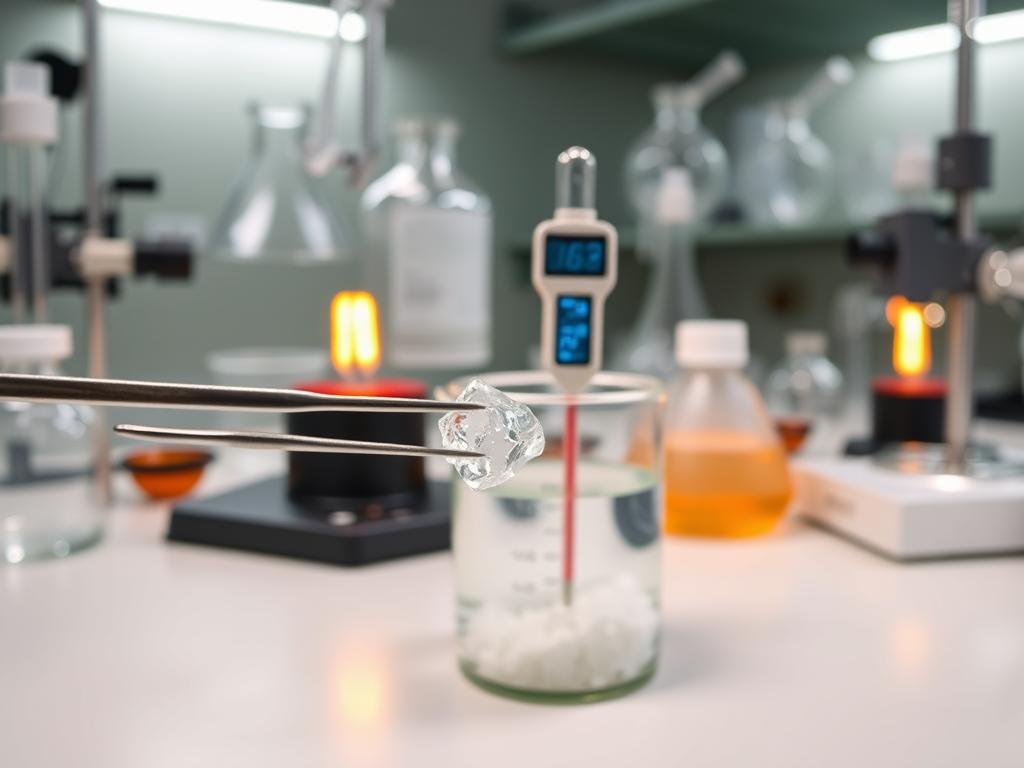Over 40% of formulation failures trace back to one thermal oversight: a process set hotter than a material can tolerate. That single stat frames why clear thermal data matters.
Rapidaccu brings 15+ years of CNC machining experience to this problem, helping teams select materials, set oven setpoints, and avoid deformation or caking during production.
Benzoic acid is a white crystalline organic compound (C7H6O2; CAS 65-85-0) with a verified value of 122 °C (252 °F; 395 K). This figure guides dryer and heat-treatment choices, and it flags near-ignition hazards since the flash point sits close to 121–121.5 °C.
This guide explains practical thresholds, how small impurities shift measured results, and how machining crews translate thermal numbers into toolpaths, fixturing, and safe handling.
For a deeper chemical profile, refer to the official summary on benzoic acid.
Benzoic acid at a glance: identity, formula, and why the melting point matters
Clear thermal data prevents costly surface defects during machining and finishing. Rapidaccu pairs real thermal values with CNC practice to avoid softening, smear, or misformed edges when parts see heat.
What this compound is
Benzenecarboxylic acid (C6H5COOH; CAS 65-85-0) is the simplest aromatic carboxylic acid. It appears as white or colorless crystals with a faint odor and a molar mass near 122.12 g/mol.
Rapidaccu insight for manufacturers
Knowing the thermal transition around 122 °C guides fixture design, tool selection, and coolant choice. That data lets teams set safe thermal envelopes and avoid local softening during cuts.
- The benzoyl group controls lattice energy, so purity affects how sharp the transition will be.
- Limited water solution behavior at room temperature changes cleaning and spill plans.
- Compare aromatic carboxylic systems to predict how substitutions shift behavior.
For a concise chemical profile, see this benzoic acid profile on BYJU’s.
whats is the benzoic acid melting point
Operators need concise phase thresholds to align lab charts with plant controls and SOPs.
Rapidaccu uses a verified value of 122 °C, equal to 252 °F and 395 K, as a specification benchmark. In controlled tests, onset and clear points should bracket that value within a narrow window.
The verified melting point value: 122 °C (252 °F; 395 K)
Use 122 °C as the reference when setting dryer setpoints, heated enclosures, or packaging ovens. Keep a safe buffer below 121–122 °C to avoid approaching the flash range near 121.5 °C.
Understanding units and scales: converting between °C, °F, and K
Converting units prevents control errors: 122 °C = 252 °F = 395 K. Confirm units in PLCs and SOPs before entering setpoints.
How it compares: phenol and related aromatic carboxylic compounds
Compared with phenol, this compound shows a sharper transition due to its crystalline lattice and hydrogen-bonding group. Sublimation can start near 100 °C, so mass loss or surface frosting often signals vapor loss rather than a true melt.
- Solubility at 25 °C is low (~3.44 g/L) and rises with heat, affecting sample prep.
- Deviations from 122 °C usually indicate impurities, hydration, or mixed phases.
- Minimize skin contact and use PPE; precise tests reduce repeat handling and exposure.
Physical and chemical profile that frames melting behavior
A concise physical profile helps predict how heat and phase changes affect handling and finish.
Identity and core numbers confirm expected transitions and guide lab checks. CAS 65-85-0, C6H5COOH, molar mass 122.12 g/mol, and a white or colorless crystalline appearance form the baseline.
Water solubility is low at room temperature (about 3.44 g/L at 25 °C) but rises sharply with heat. Sublimation can begin near 100 °C and vapor pressure climbs from 0.16 Pa (25 °C) to 0.19 kPa (100 °C), so mass loss may bias thermal readings.
| Property | Value | Processing note |
|---|---|---|
| CAS / Formula | 65-85-0 / C6H5COOH | Use for inventory and MSDS matching |
| Molar mass / Density | 122.12 g/mol / 1.27 g/cm³ | Predicts crystal habit and melt flow |
| Water solubility | 3.44 g/L (25 °C); 56.31 g/L (100 °C) | Hot-water recrystallization is effective |
| Vapor & safety | 0.16 Pa (25 °C); flash ~121–121.5 °C | Keep thermal margins; control exhaust |
Rapidaccu maps these values to fixture design, coolant choice, and toolpath rules so parts retain tight tolerances under thermal stress. For regulatory and hazard details consult this official summary.
What can shift an observed “melting point” in practice
Small changes in sample makeup or test setup can shift a measured thermal transition by several degrees.
Trace impurities and residual solvents disrupt the crystal lattice and often depress or broaden results. Rigorous drying and recrystallization tighten ranges and improve repeatability.
Purity and sample preparation
Particle size and capillary packing change heat transfer. Fine powder can lift into air currents and sublime faster.
Gentle tamping and uniform fill height help. Good batch labeling links anomalies to drying or storage conditions.

Sublimation and airflow effects
Sublimation may begin near 100 °C and will deplete samples before true transition at 122 °C. Seal capillaries or use a light inert backfill to reduce mass loss.
Technique and instrumentation
Heating rate matters: too fast yields lag, too slow raises sublimation exposure. DSC provides objective transition profiles and enthalpy data versus visual capillary reads.
- Calibrate instruments with certified standards bracketing 122 °C.
- Control dust and PPE to limit exposure and reduce explosion hazard.
- Use sealed or inert setups when possible for reliable results.
| Method | Strength | Note |
|---|---|---|
| Capillary | Simple, low cost | Susceptible to airflow and packing effects |
| DSC | Quantitative, sensitive | Better for enthalpy and subtle transitions |
| Sealed cell | Reduces mass loss | Recommended for volatile samples |
Rapidaccu recommends validated methods, sealed or inert atmospheres, and calibrated heating profiles so data used for machining and packaging reflects true material behavior.
From lab to plant: uses, hazards, and safety considerations around the melting point
Manufacturers must translate lab thermal numbers into plant controls to keep processes safe and predictable.
Key industrial use includes synthesis routes that oxidatively decarboxylate material to produce phenol and manufacture benzoate salts used as preservative products in foods and beverages.
Fire and process hazard: this organic solid is combustible with a flash near 121–121.5 °C. Dust can form explosive mixtures, so keep dust out of air and implement grounding, local exhaust, and explosion‑proof equipment.
Exposure risks include serious eye irritation and mild skin effects. Limit inhalation with containment, PPE, and eyewash stations close to work zones.
Storage and packaging: segregate from incompatible substances and oxidizing agents. Seal containers, avoid hot surfaces, and design packaging lines to minimize fines and abrasion.
| Aspect | Use | Primary hazard | Control / handling |
|---|---|---|---|
| Synthesis | Phenol production; oxidative routes | Heat release; off‑gas (carbon dioxide) | Manage heat, venting, and inerting |
| Preservative manufacture | Benzoate salts for acidic foods | Quality loss if pH mismanaged | Validate dosing, monitor water phase pH |
| Storage & packaging | Bulk and finished product | Dust explosion; fire | Dust control, segregation, sealed bins |
| Health | Handling and cleanup | Eye and skin irritation; inhalation | PPE, eyewash, housekeeping |
Rapidaccu supports safe scale‑up with process‑aware machining, packaging‑ready finishes, and documentation that align lab control limits with plant safety and quality systems.
Measuring and verifying the melting point with confidence
Validated measurement techniques reduce variability and give machining teams trust in material data. Follow controlled procedures so thermal values used for fixtures and process limits are defensible.
Rapidaccu’s quality system emphasizes calibration, traceability, and method validation. Document methods, record reference standards, and log instrument checks before any release that informs production.

Best practices for sample handling and test setup
Use sealed capillary tubes or an inert gas purge to limit sublimation and exclude air. Pack samples consistently and set a controlled heating rate to minimize lag and broadened transitions.
Quality control tools and validation
DSC gives objective onset and peak data and works well with hermetic pans. Use certified standards and periodic calibration of temperature and heat‑flow channels. Note that this compound often serves as a reference in bomb calorimetry, so handle powders to avoid dust dispersion and ignition.
| Method | Strength | Primary hazard | Recommended control |
|---|---|---|---|
| Capillary visual | Simple, low cost | Sublimation, airflow bias | Seal tubes or inert purge; uniform packing |
| DSC (hermetic) | Quantitative onset/peak | Hot stage hazards; pans can pressurize | Calibrate regularly; use enclosure and LOTO |
| Bomb calorimetry | Energy reference; stable standard | Combustion risk with fines | Control dust, use ventilated enclosures |
| Solution prep | Improves crystallinity | Solvent exposure | Standardize preconditioning; document solvent agents |
Establish validated protocols that bracket the known 122 °C value and keep audit-ready records. For lab methods guidance and practical lab exercises, see this short procedure on melting determination.
Conclusion
Good thermal control turns lab data into reliable production outcomes. Use the verified 122 °C benchmark as your guardrail and pair that value with solubility trends in water to plan drying, recrystallization, and cleaning steps.
This aromatic carboxylic acid, linked historically to gum benzoin, supports synthesis routes and benzoate preservative systems for foods and food products. Watch for sublimation near 100 °C, manage dust in air, and separate reactive substances to reduce fire and skin risks. Model carbon dioxide outputs when scaling thermal processes.
Rapidaccu brings 15+ years of precision CNC machining to align material data with fixtures, toolpaths, and finishing. Contact Rapidaccu to match your component needs with controlled processes and proven material science.

